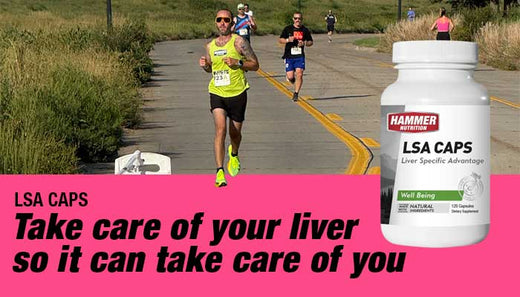
BY DR. BAYNE FRENCH
In Part 1, I detailed the specifics of the FASTER study, so the antithesis of high sugar fueling may be understood. With knowledge of the extremes, perhaps a healthy and enjoyably sustainable fueling method could be developed for your own endurance demands.
Biochemistry and Metabolism:
I do believe the best decisions are made in an educated state, free of bias. Becoming educated and shucking bias are truly transcendent human attributes, thus exceedingly rare.
I think it critical to have a basic understanding about what happens chemically when your blood stream is flooded with sugar. With this knowledge you may choose to stick with the status quo because it is working for you, or you may choose to go a different direction entirely.
I have written about metabolism many times. I feel that most diseases, most of what we will all die of, is a result of distorted metabolism. A sick metabolism leads to unwanted weight gain, type 2 diabetes, stroke, heart attack, Alzheimer’s disease, and cancers. Having an efficient metabolism reduces disease, medication, ass-time in doctor’s offices, and enhances health span and lifespan in a remarkable way.
My entire perspective on health and wellness, including athletic fueling, is viewed through the metabolic lens.
Metabolism involves the conversion of food particles to energy, and the storage of these particles for future energy. The overview is this:
Food + Oxygen = Carbon dioxide, water, and energy.
Food contains a lot of stuff, like fiber, vitamins, minerals, pigments and other nutrients. For metabolic purposes whether it is protein, carbohydrate, or fat, food consists of carbon, hydrogen, and oxygen. Protein also contains nitrogen. Just 4 basic elements.
This is not an exhaustive discussion of biochemical reactions. The topic of this article is a discussion of high carbohydrate fueling for exercise and its resultant harms. Consequently, the focus will be on blood sugar.
Sugar is sucrose. It consists of one molecule of glucose and one molecule of fructose linked together. Most carbohydrate, whether sucrose or a slice of bread, is broken down in the intestine to single molecules of glucose and fructose.
Glucose is absorbed into the blood stream by its own transporter complex called SGLT1. Fructose has its own transporter called GLUT5. These are the transporters that Dr. Jeukendrup, discussed earlier, showed could be increased in number and efficiency with “gut training”.
Enzymes are proteins that help a chemical reaction move forward. There are enzymes that specifically metabolize glucose. When glucose builds up and is in excess, these enzymes are shut down. This is called feed-back inhibition.
Despite huge amount of sugar consumption, and heightened sugar absorption from the gut from “gut training”, there are still bottlenecks with how much glucose can be converted to energy, ATP.
And THIS is what we’re really trying to do…make lots of ATP because this is what makes muscles move.
Insulin:
Insulin is a hormone that is made in the pancreas. Like all hormones it travels by the blood stream and exerts effects far removed from its organ of origin. There is no more potent modulator of metabolism than insulin.
When there is an increase in blood sugar, insulin is released. All of our 40 trillion cells have a docking port on their surface for insulin. This allows sugar to go from the blood and into the cell. Insulin is potently anabolic. Meaning it builds things. It builds muscle, glycogen (storage form of carb), and is particularly good at building fat.
First of all, with heavy exertion, it does not make a lot of chemical sense to have a hormone spike that is responsible for building things, when we really need to break things down to provide fuel. However, insulin is very good and in fact vital and allowing the entry of glucose into the cell. Glucose then undergoes a chemical process called glycolysis, and a little bit of energy is made in the form of ATP. After glycolysis, glucose remnants then enter the citric acid cycle, and eventually oxidative phosphorylation. This last set of reactions results in the majority of ATP formation.
ATP is directly responsible for the movement of our muscles. And this is what endurance athlete’s really care about…repetitive, prolonged muscle movement under a load, preferably performed better than everyone else in the race. Some athletes want this so badly, metabolic consequences be damned.
As mentioned, insulin is the most potent metabolic hormone. It is so powerful that to counteract its effects requires 3 other hormones: Glucagon, epinephrine, and cortisol. We already discussed that insulin is what allows glucose (blood sugar) to enter the cell. Inside the cell is where glucose is converted to energy, ATP.
Insulin has many other effects:
- Formation of glycogen, our form of carbohydrate storage.
- Prevents the breakdown of glycogen.
- Causes the conversion of carbohydrate to fat.
- Increases percent body fat.
- Prevents the breakdown of fat.
- Helps convert protein into muscle tissue.
- Stimulates glycolysis, the first step of glucose metabolism inside the cell.
- Prevents gluconeogenesis, the formation of new glucose.
- Prevents the conversion of lactic acid into glucose.
- Results in cellular proliferation, increasing the risk of heart disease and cancer.
Metabolic Consequences of Elevated Insulin:
When blood sugar is elevated and insulin levels high, you are a One Trick Pony. You cannot use protein and fat to create new glucose in a process called gluconeogenesis.
More importantly, you are unable to access fat for fuel. Fat tissue is broken down in a process called lipolysis. Insulin directly inhibits this. After fat is broken down it is metabolized in a process called beta-oxidation. Insulin further inhibits this reaction. Consequently, the dramatic amounts of energy (ATP) that fat is capable of providing is completely unrealized in a high insulin environment.
Lactic acid is normally made in the process of glycolysis. Much more is produced with strenuous exercise. High-level athletes recognize this chemical as causing soreness and being basically a nuisance. Lactic acid can however be a source of energy. It can be taken up from the blood stream by the liver and converted into more glucose. Insulin interferes with this process.
Heart muscle preferentially burns fat for fuel. Heart cells are very adept at performing beta-oxidation, breaking down fat into smaller pieces that then enter the citric acid cycle, and eventually oxidative phosphorylation to yield a huge amount of ATP.
Insulin directly interferes with the breakdown of fat and the heart’s ability to create energy. I could be wrong but I think most endurance activity requires a well-functioning heart and high insulin levels from a blood stream flooded with sugar directly impairs the hearts’ ability to burn fat.
Mentioned in the section above is that insulin stimulates proliferation, or growth, of cells. Fu et al. (Mol Metab. 2021) reports how insulin directly and indirectly affects arteries “exacerbating the development of endothelial dysfunction, atherosclerosis, restenosis, poor wound healing and even myocardial dysfunction”. These abnormalities are independent of blood sugar levels.
Patil et al. (Mo Med. 2012.) details the myriad cardiovascular complications that can afflict endurance athletes. These problems occur at a higher incidence, and at an earlier age in endurance athletes. Insulin is a primary driver of this.
Leitner et al. (Biochem J. 2022) in a fascinating article titled Insulin and cancer: a tangled web details the chemical reasons behind how insulin can drive cancer formation. Thirteen cancer types are found to occur with much higher incidence in individuals with obesity. A primary driver for the vast majority of individuals with obesity is chronic hyperinsulinemia (ongoing and prolonged elevated insulin blood levels).
Although Patil et al. above reported on cardiovascular diseases in endurance athletes, there is no compelling evidence to date that endurance athletes incur a higher risk of cancer. There is however, a mechanism of heightened risk associated with high insulin levels. Recommendations of 60-90 grams of carbohydrate per hour results in extreme insulin formation from the pancreas.
Muscle Types:
Maybe you have heard about white and red muscle types. It is as true in your Thanksgiving turkey as it is in us.
White muscle is lighter in color. It is considered a fast-twitch muscle type, capable of burst contraction. The turkey breast possesses this type of muscle. Sprinters and weightlifters also have a disproportionate amount of white muscle. White muscle is most efficient at burning glucose to create ATP.
Red muscle is a slower-twitch muscle fiber, capable of prolonged, sustained and repetitive contraction. Sounds a lot like endurance movement. Here is where high carb fueling recommendations becomes incongruous with efficient movement. Red muscle is most efficient at burning fat as its primary fuel to form of ATP. High carbohydrate fueling flies in the face of this. Thus the advice from Dr. Jeukendrup and Andy Blow is made further questionable.
A Bit More Biochemistry:
I detail how sugar detrimentally affects performance in an article Sugar. The Antithetic Performance Enhancer. A couple (of the hundreds) of highlights from the article:
- Nitric oxide is a potent chemical produced by the body that increases blood flow to tissues. It also allows entry of glucose into muscle tissue. It is a performance enhancer. Sugar directly interferes with the formation of nitric oxide.
- Sugar drives the formation of antidiuretic hormone (ADH). This means you urinate less, holding onto more fluid, further interfering with your power to weight ratio. Furthermore, ADH is a vasoconstrictor, meaning it constricts blood vessels to muscle. None of this is helpful for performance.
Recall that half of sugar is fructose. Fructose is a potent driver of uric acid which is associated with multiple chronic diseases. Although uric acid is most known for causing gout its metabolic effects are wide reaching. Here is an excerpt from that article I wrote Uric Acid and Its Metabolic Effects:
Whether you are afflicted with gout or not, elevated uric acid drives the formation of insulin resistance, elevated blood sugar, type 2 diabetes, elevated blood pressure, distorted cholesterol, systemic inflammation and weight gain. It is directly implicated in a large percentage of all-cause mortality and especially cardiovascular disease (Chen et al. Arthritis & Rheumatology Feb 2009).
The evidence between elevated uric acid and metabolic mayhem is strong enough that it is considered an independent risk factor. This means that on its own, elevated uric acid corresponds with disease.
An average adult human mammal has about 400 grams (14 ounces) of stored carbohydrate in the form of glycogen. This corresponds with less than 2000 calories. This amount could singularly provide enough ATP for 90-120 minutes of vigorous exercise.
A lean adult human mammal can have 10 kilograms (over 20 pounds) of fat providing upwards of 100,000 calories.
With excessive sugar fueling, blood sugar levels spike. Glycogen stores may stay replete but there is a lot of blood sugar left over. It will invariably spillover into fat formation. The stress hormone cortisol is elevated with heavy exertion. Cortisol will preferentially direct fat storage into the midsection, creating visceral fat. This type of fat is different from fat stores under our skin, called subcutaneous fat. Visceral fat releases hundreds of unfavorable chemicals that drive organ dysfunction over time.
High sugar consumption > Elevated blood sugar > Elevated insulin > Insulin resistance
Further elevated insulin > Increased cardiovascular disease and cancer risk > Fat formation and inability to burn fat
Exercise and relative reduction in calories (as in lower carbohydrate endurance fueling) triggers the formation of a protein called AMP-activated protein kinase (AMPK).
Stay with me here. AMPK does so many good things. Two of which are:
- AMPK stimulates mitochondrial biogenesis. This is the formation of NEW mitochondria, and mitochondria are what make ATP that fuels your performance.
- AMPK stimulates the process of autophagy. This is the removal of damaged and old cellular components. It’s like cellular housecleaning. Poor autophagy is a driver of several diseases.
Let’s End This Thing:
I have absolutely no use for high carbohydrate fueling during exercise and no respect for it being recommended. I view it to be health harming on many levels. There are no disputing myriad metabolic effects of sugar, none of which are favorable. If you try to dispute them you are either ignorant, mired in dogma and the status quo, or on the payroll of some sugar-touting entity.
There are so many metabolic flaws to the recommendation for high carbohydrate fueling during exercise. With inane practices of sugar-gorging, it is not biochemically possible to create a huge amount of energy from fat; perform mitochondrial biogenesis, and autophagy. Furthermore high insulin results, driving visceral fat formation, cardiovascular disease and numerous cancers.
I’ve put myself through physical suffrage that I wouldn’t wish on people I dislike. And that’s a lot of people. Exertion and discomfort that sometimes went on for days in pursuit of things with points and full curls. I’m all about seeking an edge, and investigating that which could confer an advantage over other mammals of my own species or different. Stuffing myself with a known toxin and a primary perturber of a healthy and efficient metabolism is not an “edge” at all, regardless of the resume of the pontiffs recommending it.
It is a leap of faith in a way, to undergo a complete metabolic change in how you generate fuel. It takes time, perhaps upwards of a year, to be truly “fat adapted” meaning able to extract vast amounts of energy from the burning of fat. It is the rare high-level endurance athlete that will change a behavior that seems to be working well for them. Especially given that their window of optimal performance is relatively short. I am not writing for these people.
If you are not of this extreme performance persuasion, I would urge you to buck this metabolically flawed trend. Do not be a One Trick Pony, completely dependent on sugar to generate ATP. Lower amounts of carbohydrate consumption per hour results in lower amounts of insulin. Fat stores are then accessible which lead to an amazing amount of ATP for muscle contraction. Importantly is that lower insulin level over time that confers a much lower risk of disease.
Always be your own advocate. The willingness to follow deeply flawed and unhealthy guidelines has a lot to do with psychology. Observing influential people doing something with good results drives a similar behavior. Break free from this. Ask yourselves difficult questions. Understanding basic mechanisms is a platform from which you can embark on a different and much healthier exercise fueling strategy. I hope this article provides that for you.










17 comments
Hello, thank you for this two part article and its details. Since I am a long time Hammer Nutrition and supplements user, can you recommend the products and dosage for most endurance cycling events, gravel racing, Mountain bike, and road races, all longer than 3hours? I typically use Heed for 1.5-3 hour rides, and Mountain for rides of 2-4hours plus. I follow the dosage recommendations per lb of body weight, but with all the marketing recommendations for high carb consumption, it can make one question what is actually correct. Of course it all varries based on performance output I would assume, but for most experienced endurance age groupers is the 30-60 grams more in line? Your article makes perfect sense, but how much is actually ok, as 60-90 is too much? Kind regards
———
Hammer Nutrition replied:
Hi Shaun, Thank you for your comments and questions. I’m a bit confused as to what you use on longer rides, but I think you are on track here. HEED and or Hammer Gel for rides/races lasting less than 3 hours, Nut gels, Perpetuem or Sustained Energy for efforts over 3 hours due to their protein content. In 38 years, I’ve not come across an athlete, elite or not, that can maintain even 75 grams per hour for much more than 2-4 hours before they get sick. 30-60 grams per hour is works for most athletes in most cases. 45 grams per hour is my happy place and matches my system of using your bodyweight as your hourly target. I weigh 170 and take in about 180 per hour. I’ve gone up to 220-240 but don’t go any faster and don’t feel as good. All that being said, if anyone wants to try to go higher, I’d argue that complex carb, low osmolality products like Hammer give you the best chances compared to the sugar based, high osmolality products. BDF
I absolutely love how you clearly break down the science for those who are not exercise physiologists like myself. My husband is 62 and he is still racing mountain bikes, and winning his age group. He uses Hammer for all of his supplements and race planning. Thank you for sharing your knowledge. This is a very well written article which will be helpful for many. My motto is, “Less is more especially as we age.” I will gladly share this article with my athletes.
———
Hammer Nutrition replied:
Hello Holly, thank you kindly for your affirmative comments, support and for sharing. Please thank your husband for me as well. Hard to argue with winning results, and like you, we’ve been saying “less is best” for over 30 years. We’ll be continuing this discussion going forward. BDF
wow!!!…what an amazing second chapter to this topic..I mean for the last couple of years as I have seen these crazy amounts of sugars being ingested I wondered—where would it end…on the surface, without looking at the science, it sorta makes sense..but…these two articles you have written really do help clear the fog..of course my next question is, how do I train my 67 year old body to be more fat adapted..I don’t race any longer, I did for many years…now I just love to test my endurance…challenging myself—-setting goals and attempting to do something!!..usually in the longer endurance realm…thanks so much to Hammer for getting this out there…very appreciated, cheers
———
Hammer Nutrition replied:
Hello Jimi,
Thank you for your enthusiastic, supportive comments. Unfortunately, it ends with metabolic dysfunction and a host of not fund conditions that it causes. We’ve written several articles on high fat/protein diets and intermittent fasting in past issues of ENW and EN. I’ll be writing more on exactly how to transition from carb adapted to fat adapted in our daily diet. It’s not Keto for sure. It’s a gradual process and definitely involves working through the cravings and hunger pangs, but they only last for a few weeks. Stay tuned for that and in the mean time, feel free to peruse back issues and previous articles. BDF
As a long time customer, I have a tremendous amount of respect for Hammer and your science based nutritional outlook. And I follow your arguments regarding the goal to avoid spiking blood sugar levels which lead to release of insulin.
But like others I hear about pros like Mathieu Van Der Poel supposedly taking in 120g/hr of carbohydrate and it makes me wonder. Could elite pros be metabolizing so much fuel that high sugar intake does NOT spike their blood glucose? With the greater availability of blood glucose monitoring I had kind of guessed the pros have worked this out but haven’t heard either way. I, have nowhere near those nutritional needs or abilities, but it would be interesting to know what is going on with the pros and if any of it translates to us humans. Again, thank you for your perspective.
———
Hammer Nutrition replied:
Hello David, thank you for your candid comments and questions. Since the beginning, I’ve pointed out that elite/world class athletes are born, not made. Hi Vo2Max and lactate threshold come from more efficient and or larger organs. It’s only when extreme genetic giving (nature) is combined with highly disciplined training (nurture) that greatness like winning TDF can be achieved. What started as a simple “90-100 grams per hour” mantra seems to have morphed into a kind of competition to see who can claim the highest number. I think they are maintaining high blood glucose levels by continuous sugar intake, and therefore insulin levels. As discussed in this article and many previous, that’s a recipe for not only massively impaired fat metabolism during exercise, which is necessary during multi hour efforts no matter how high the intensity, but also ironically creation of fat from the overflow of unprocessed sugar. Unfortunately, I do not see a trickle down effect that offers benefits to the rest of the world. Pro cyclists generally have relatively short careers and often times suffer from poor health in their later years. For all of these reasons, I do not look to that group for guidance or emulation. BDF
Thank you for this detailed look at healthy and unhealthy metabolisms and their mechanics. I was left wondering what your recommendations are if not sugar as a fuel. Things like maltodexrin in Hammer gels? How does one become a fat burner?
———
Hammer Nutrition replied:
Hello Michele, thank you for your comment and questions. Yes, I recommend long chain maltodextrin, preferably from tapioca/cassava as a preferable alternative to sugar. In the short term, the idea is to always begin your exercise in a fasted state, stomach completely empty and begin light fueling 15 minutes after you begin. Over time, the idea is to switch from carbs (grains and starches) to healthy fats and proteins, plus compressed eating. We’ve written many articles on both subjects previously. BDF